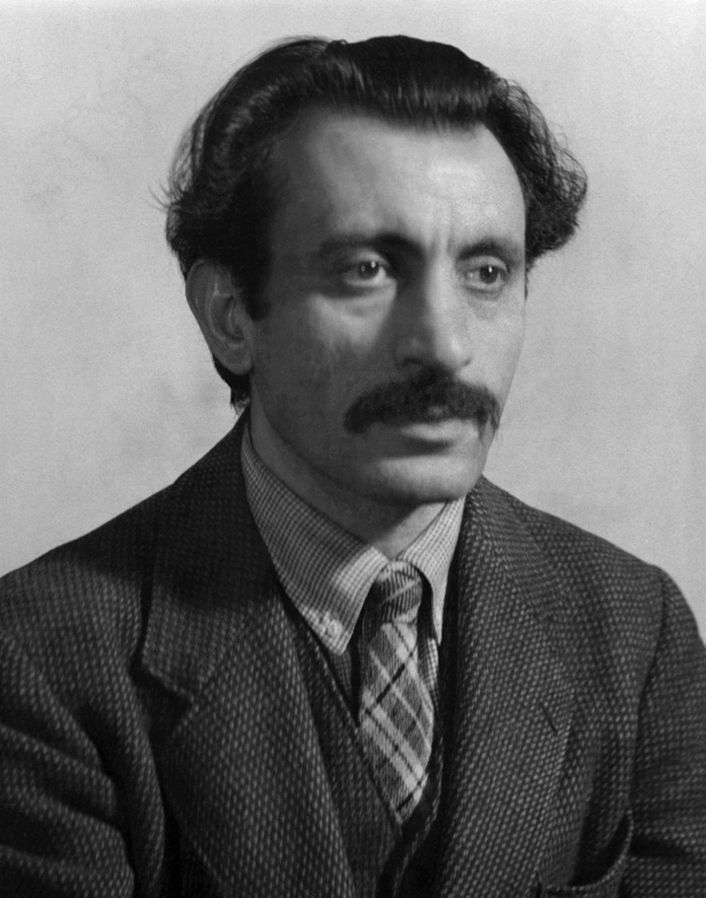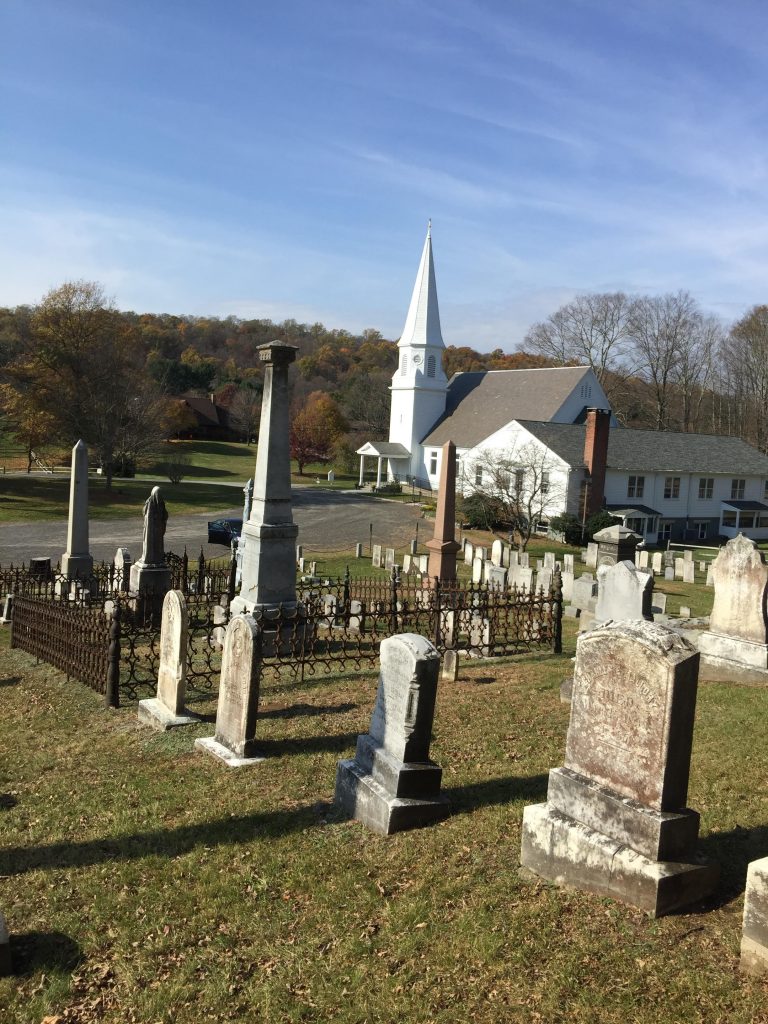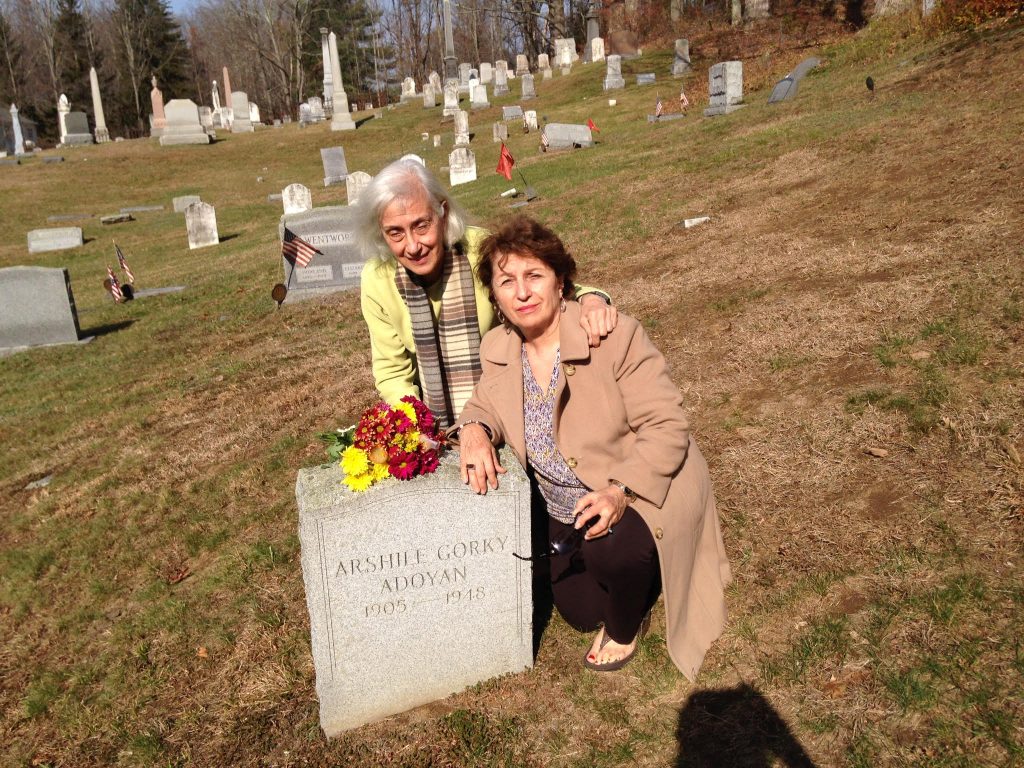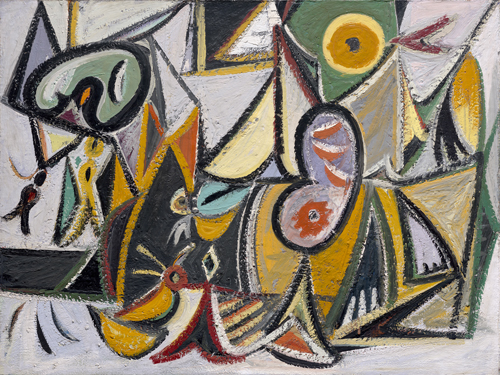On a clear autumn day, my cousins and I proceeded north toward Sherman, Conn. The 75-minutes’ drive was pleasant on the scenic country roads. In Sherman, we couldn’t find any souvenirs of Arshile Gorky. Gorky was not commercialized here.
Our intention was to find his grave and learn of his story. As an Armenian, I knew some things about Gorky, following a wonderful presentation by art expert, Mrs. Knarig Akiskal and her psychiatrist husband, Hagop Akiskal (a psychiatric analysis of Gorky’s mental state presented through pictures), and a film I had seen that granddaughter had made. I had even seen his paintings at Montclair Art Museum in N.J., yet, I searched for more.
Gorky’s Gravesite
We learned that there are two cemeteries in Sherman. The northern, next to the Methodist church on Route 10, seemed to be an older one that dated to the early 19th century when the township—or rather, the village—of Sherman was founded by the Northrop family. The newer one was closer to the township school. We stopped at the only convenience store in town to buy a bouquet of flowers for Gorky’s grave. From there, the direction was clear; we found the church and the cemetery.
Finding the grave took some time, since the old tombstones caught our attention and distracted us. It was my cousin that finally found it. The Gorky family had bought the land surrounding the grave, thus making it stand by itself. Yet, since his burial in 1948, the cemetery was populated and Gorky’s tombstone did not stand by itself.
Gorky’s stories are numerous and contradictory, and some fabricated; I shall list here what I discovered. I have yet to read the books I ordered about this enigmatic artist.
A newspaper article stated that the Methodist church refused to bury Gorky since he had committed suicide. Yet, the church conceded to hold the burial without a church service. Gorky had only lived in Sherman for two years before his death in his early 40’s. He had rented the “glass house” and had intentions to set house in Sherman permanently before the tragedies. As to why he moved to Sherman, I was told that this was a serene place where artists chose to live; in addition, I conjectured that the rent was perhaps inexpensive for the young artist, since Sherman being so far removed from the big cities.
Gorky’s Biography
Gorky was born as Vosdanig Adoian (Vostanik Adoyan) on or before 1904 [his gravestone states, 1905-1948], in the village of Khorkom on Lake Van (currently, Eastern Turkey) to an Armenian farmer and his wife, the daughter of a priest, in a re-constituted family (second marriage to the couple with children).
Gorky was the middle of three children. His mother had lost her first spouse during the Turkish massacres of Armenians in 1896; the marriage was arranged. In 1908, his father fled to the United States to avoid the Turkish draft and its policy of using Armenians to kill other Armenians. In 1915, when a new wave of massacres threatened Armenians, Shushan Adoian and her two younger children found refuge in “Caucasian Armenia.”
Shushan, Gorky’s mother, Vartoosh, his sister and young Vosdanig (called, Manouk) moved from place to place. In 1919, while in Yerevan, Shushan fell gravely ill and died of starvation [Armenia was stricken with famine in the early years of the republic] even though Vosdanig and Vartoosh worked hard to bring food to her. That day, as she dictated a letter to young Manouk for her husband in America, she died in his arms, her head falling on him.
Vartoosh remembered that Shushan was 39 then and that Gorky and Vartoosh were young and they did not know what to do. Her body was swollen from starvation. Shushan used to save the food the children brought home for her. Shushan loved them and the children loved their mother very much. For Gorky, she was no less than a goddess. He never forgot her and always painted her with all of his soul. Vartoosh remembered that they ran, while her mother’s body was taken to a mass grave for those who died that day. The children fled, helped by Armenian friends and relatives, until they reached Constantinople.
After several months there, they managed to leave for the United States via Athens. Gorky was a teenager when he arrived in Watertown, Mass. with Vartoosh in 1920. Years later, whenever he reminisced, he emphasized the “innocence and beauty of growing up on the shores of Lake Van.”
From 1926-45, he painted two pictures of his mother, based on a 1912 photograph and from memory.
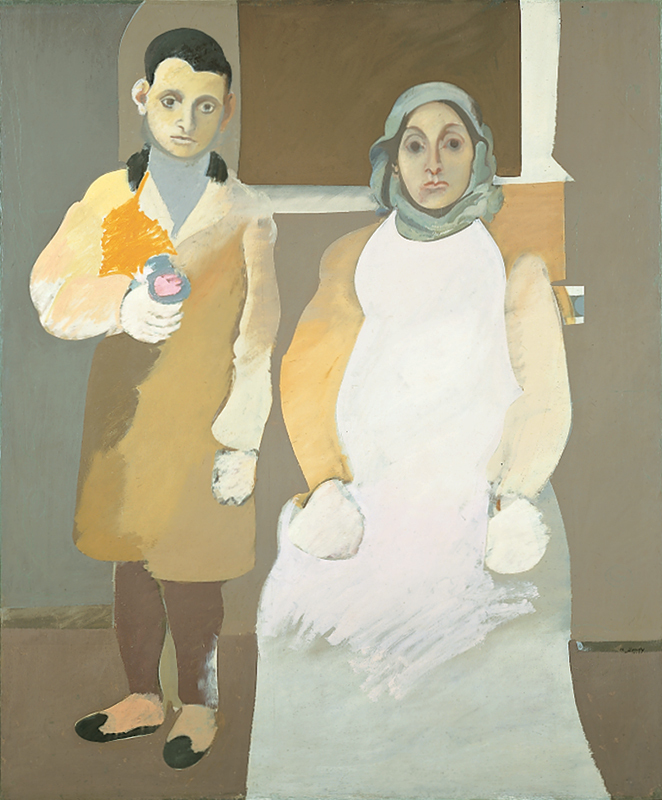
‘The Artist and His Mother,’ based on a 1912 photograph, one of several paintings done 1926-1936 (The Estate of Arshile Gorky/Artists Rights Society, New York)
Gorky managed to obtain a fine education in the United States, despite his poverty. He seems to have fit in the art world and built significant friendships. He carried the European tradition to the United States and developed the art of abstract expressionism. His artist friends emulated his style, thus, recognizing him as the leader of a significant movement in American art which seemed to blossom more after his death. In fact, his reputation seems to have grown more after his death.
Narratives and Anecdotal Entries
A Wall Street Journal article referred to Gorky as “a poet of nostalgia” in particular, during his later years, in reference to his exhibition in Washington, D.C., “Arshile Gorky: The Breakthrough Years,” a collection of 42 paintings and drawings from Gorky’s last decade. The journalist stated: “Few artists were ever more valued by their peers. Tall, dark and mustachioed, Gorky cut a dashing figure as he paraded through the streets of Manhattan in his flowing black coat. His studio on Union Square became a hangout for a growing corps of talented unknown artists. Many were foreigners, few had money, and they shared a heightened respect for the European avant-guarde. Surely no one worshiped the School of Paris more than Gorky, whose feelings for Picasso were a legend. Once when someone asked Gorky about a rivulet of pigment in one of his works, Gorky boomed, ‘When Picasso drips, I drip.’”
According to one writer, the art world which felt comfortable for him, had replaced the family Gorky lost in Armenia.
In 1945, several misfortunes affected Gorky. The studio (near the Hebbeln House in Conn.) where Gorky was working, caught on fire along with most of the paintings he had done for several years. Shortly afterwards, he underwent a severe colon operation that left him in a permanently weak state.
Then, in early July of 1948, Gorky, a passenger in a car that overturned (on Chicken Hill, near New Milford) left Gorky with a fracture of two vertebrae. After 10 days of hospitalization, he was released, and had a complicated brace for a tear in which he could no longer paint, according to one source. The driver of the car, Julien Levitt stated in his memoirs that when he met Gorky again, Gorky prepared a canvas for painting. On Wednesday morning, Gorky telephoned friends in Roxbury and New York. The friends were so concerned that they contacted Gorky’s neighbors to make sure that he did not harm himself. The neighbors hurried to his house but found it empty and searched the grounds.
At 1 p.m., Gorky’s dachshund began barking and nipping at the heels of two searchers as they approached a shed (near the old stone crusher) in the Hebbeln property. They later found Gorky hung from a beam. Gorky had been in his early 40’s.
Gorky had the habit of telling different stories to different people. Gorky found it exciting to present himself as a Russian, although he did not know a word of Russian.
The paper continued, “In spite of early hardships, he managed to acquire a surprisingly extensive education, and in matters of art history, he was a real scholar. His talent as a painter was slow to be recognized, but right before his death, he had been increasingly successful, so that his work was represented in several museums and many private collections. His exhibition of the year before was widely discussed and he was preparing for another exhibition until the automobile accident forced him to stop working. A suicide note scribbled on a wooden crate read, ‘Goodbye, My Loveds.’ Several of his colleagues were present at the funeral service on Friday, July 23.”
Gorky and his family had rented the historic Samuel Page House [21 Spring Lake Road] in Sherman also known as the Hebbeln House featured in Life, Architectural Forum, and House Beautiful magazines, in 1947—which was renovated the year before and was referred to as “the glass house.” His wife, Agnes Magruder, two little girls, Maro (5) and Natasha (3) were visiting Agnes’s mother when they received news of the tragedy and hurried home. They planned on living in New York to the regret of their neighbors since Gorky was recognized as an artist of exceptional gifts who was going to be missed.
Solomon writes, “It has often been observed of Gorky’s work that hints of his Armenian past –a slipper or a plow or a tree –are embedded in otherwise abstract images. Yet his nostalgia was not nearly so literal, and also expressed itself as sexually pining. ‘The Liver is the Cock’s Comb’ (1944), the artist’s largest painting and perhaps his best known, is a garden contrived from red-hot body parts. A mound of quivering, swollen organs mingles against a billowing white form in the background that suggests a woman in an apron. Here, all of Gorky’s infatuations—from Miro to his mother to the landscape of his youth—dwell together in a paradise that exists on no map.”
Gorky was controversial and he seems to have contributed to the controversy. His son-in-law, Matthew Spender who wrote his biography writes, “Almost every fact about Gorky’s life needs to be qualified… His birthday was April, except that sometimes it was in October. The year of birth declared on his naturalization certificate was 1904, but Gorky always looked older than his supposed age.”
Solomon wrote, “…Gorky was an American great, and he deserves to be remembered for something besides the various people that he connected… If Gorky was a pioneering abstract expressionist, it needs to be said that he was more than that, and that he achieved things that none of his contemporaries ever did. He was, for instance, more focused on the human body than any other painter of that school. While de Kooning, too, was enamored of the human figure, the women in his paintings are man-eating monsters lifted from Picasso. Gorky’s women are much more erotic.”
Levitt, challenged Spender’s quote that “Gorky never … made a personal friend of his dealer or flattered a buyer…. “ and added that Julien Levy (Memoirs of an Art Gallery, Putnam, 1977), in fact exhibited Gorky’s paintings in New York and also was the driver of the car when Gorky’s neck was broken.
Levitt notes that Litchfield County was a gathering place for Surrealists from 1930’s to 1960’s, such that dealer and artist had personal associations. Julien wrote that Gorky and he had a lunch gathering in Ridgefield, at the home of Allan Roos, a Freudian psychoanalyst and friend of Julien’s who would give Julien a boxer puppy. Allan, according to Julien’s memoir, took Julien aside and expressed concern that Gorky was “depressed,” to which Julien said he had reason to be. Gorky reportedly had just told him that his wife, affectionately called, “Mougouch” was leaving him.
There is a note by Levitt that Gorky told Julien that Mougouch intentionally left her diary open on the kitchen table for Gorky to read before she left. Gorky reportedly was in utter despair and did not know what to do. Allan Roos suggested to Julien that Gorky get help. Julien remembered answering that it was offered, that Mougouch and Jeanne Reynal (another Surrealist artist-friend) had urged Gorky to try Jungian analysis after his cancer operation but that Mougouch had warned Julien not to mention analysis since “the very idea throws him into a rage.”
After lunch, Julien convinced Gorky to return to his farmhouse in Bridgewater for dinner. Gorky was reluctant since he wanted to be home in Sherman in case Mougouch called. They began to prepare a steak dinner when a violent summer thunderstorm knocked out the electricity. Gorky became frantic. With the half-cooked food and the puppy, they set out for Sherman where there were grills and pots to cook in Gorky’s large fireplace.
Driving through a blinding thunderstorm, the car went into a slow skid on Chicken Hill (Route 67 descent into New Milford, before the firehouse and Route 202) and seconds before the accident, as Julien’s eyes briefly met Gorky’s, Julien reportedly felt a “black presence exuding darkness all over them…” As the car rolled over on its side, Gorky fell heavily on Julien, breaking Julien’s collarbone. They were taken to the hospital where they were X-rayed and Julien’s shoulder and arms were wrapped. Gorky reportedly arranged to get a ride home from someone else.
The next day, as Julien, Yves Tanguy (another surrealist) and his wife were taking the puppy from the vet, they picked up Gorky to have lunch at Julien’s; Gorky had told Julien, in the morning, that he had a terrible headache, felt lonely and depressed. There, they received a message from the hospital that the X-rays had been re-examined and Gorky had a broken neck. Gorky was hospitalized for 10 days. Mougouch returned to care for him. Julien reported (in his memoir) that he saw Gorky once after his release. He found Gorky happy, surrounded by his children, cared for by his wife, and preparing canvases to paint again. Julien wrote, “He looked like some barbaric warrior in the strange armor of his leather and steel neck brace, and he showed /me/ a model of an arbalest he was carving.” Julien made no mention of Gorky’s right arm being paralyzed. Julien reportedly took “some small comfort in the fact that Gorky’s chronic financial woes would be eased by the insurance money due him from Julien’s /auto insurance policy.
Julien wrote that late at night on July 20, 1948, Gorky called Julien and asked, “Can you get me a woman? … Gorky said he was searching for occasional companionship, occasional cooking and occasional sympathy. Since it was close to midnight, Julien reportedly suggested he get some sleep and they would think of someone in the morning. Soon after, Tanguy’s wife called Julien who told her about his conversation with Gorky. By comparing notes, they realized Mougouch had left again. Tanguy thought Gorky sounded drunk or crazy, while Julien thought Gorky sounded perfectly understandable, given the circumstances. Tanguy said Gorky told her he was calling all of his friends. He seemed to be asking for something different from each person. This was strange, thought Julien, since Gorky rarely asked for favors from anyone, although he was warm and generous with others.
Julien and Tanguy agreed someone should go to Gorky, and since Julien could not drive, Tanguy offered to ask Peter Blume (an artist friend in Sherman) and Malcolm Cowley (a writer near Sherman). Tanguy learned that Blume would check on Gorky the next day. The next morning brought news of the suicide, to this group of artists. Gorky’s funeral service and burial was surreal. Finding a cemetery plot and a compassionate priest to bury a suicide case proved to be difficult. A priest from Roxbury agreed while the Methodist church allowed the burial with no religious service. Mougouch’s father, the “Admiral” joked and shared a nip of whiskey before the superficial service on a day when the rain drizzled, then turned into a downpour, soaking up everyone.
Suddenly, Mougouch, dripping wet and hovering over the casket on the ground, insisted that the grave be filled with earth “to the last shovelful.” A few mourners remained until the last spade-full of dirt was finished and the sod replaced. Mougouch then stamped down the earth, to some appearing to dance on the grave.
Later, Jeanne Reynal told Julien the details of the suicide. Gorky had called many friends that night for different reasons. He became progressively more intoxicated, although he reportedly decided to die long before beginning to drink. He had hung many nooses from different branches and rafters in favorite spots. His final choice for suicide had been a rope tied around a beam in a shed where he often went alone to read or dream. Julien said, across the rafter he had written in chalk, “Goodbye My Loveds.”
Julien closed his gallery in New York after Gorky’s death, following a season when he held a Gorky retrospective. That gallery was a gathering place for many very creative artists, Surrealists, some of who then lived in Litchfield County, like Gorky., before Abstract Expressionism diffused into the dominant form, Gorky being the grandfather.
Gorky the Artist
According to Solomon, it was in the 1940’s that Gorky found his true voice.
Gorky became the powerful figure of Abstract Expressionism after his death in 1948. He was already a pivotal figure in Abstract Expressionism and Surrealist movements before he moved to Sherman in 1946. He had had several one-man-shows until then and his popularity was increasing in spite of mixed reviews. He reportedly had a great influence on other painters. His works are hung in important modern art museums in the world, such as the Guggenheim (New York), the National Gallery of Art (Washington, D.C.), the Museum of Modern Art and the Metropolitan (New York).
William de Kooning, friend and disciple, said, “From the way he spoke about art, I know that there were secrets that he knew that no one else did, that he had seen what others hadn’t, that he had a secret gift, an extraordinary perception of understanding things, this terrific eye for seeing what makes art tick—and I was supposed to know more because I had gone to the academy and belong to Western tradition, but actually Gorky knew much more than I, and it was this schooling in Armenia that so fascinated me.”
Both Mougouch and de Kooning were reportedly shocked at how little they knew about the man, that Mougouch did not even know Gorky’s real name. Apparently, Gorky was a fascinating storyteller, like his compatriots in Khorkoom, and had invented the story of his life.
His greatest work, writes his son-in-law, Matthew Spender, was his attempt to re-capture the pure simplicity and tragic turmoil of his early years.
His accounts were a fabulous mixture of truth and fantasy. According to Spender, “So much had been destroyed. It was Impossible to come to terms with the loss. An act of non-remembering, which was not forgetfulness but postponement of thought, was the only response.”
His love for painting was noticed by his teacher in Khorkom. In 1920, he worked at a rubber factory in New England; but since he wanted only to paint and had had little patience for schooling, he spent much of his time drawing on the black tar paper roof and even though a co-worker tried to cover up, the factory soon let him go. He moved about New England, drawing and painting; he briefly studied drawing at the technical high school in Providence, R. I.. He fabricated the story that he had studied engineering at Brown University.
He began to change his name to separate himself from his unresponsive father and half-brother with whom he briefly and unsuccessfully stayed in Providence. Until 1930, he used the names, Archie Gunn, then, Arshel Gorky. Arshel may have come from “aysharel” (possessed by evil spirit). He told friends his mother called him, “the black one” who would not have a good end. Later, he said that he was the nephew of Maxim Gorky, the Russian novelist. There is another narrative that he took the name from Göhk, the spelling of Khorkom on old maps. Thus, his artist’s name was, “the accursed one from Khorkom.” His children’s babysitter remembered, “He was a beautiful-looking man, so dark and dramatic, always with a dark cape and that thick moustache.”
Leaving Boston for New York in 1925 to teach, he told a friend, “I shall be a great artist or else a great crook.” He found New York art world indifferent to contemporary art. Paris was the heartbeat of the art world then. He claimed he had already studied in Paris as he returned to America. At the Grand Central School of Art, he appeared charismatic to few students and scary to others. He fell in love with an Armenian girl and was obsessed by her, with possessiveness, rage, and jealousy.
He often told his students that painting must be “artificial” to be good, insisting that it should be impersonal, while his early work was both original and personal. His early self-portraits tell the story of the influence of the great European masters. After a failed marriage to an art student, and a love affair, in 1940, he met the love of his life, Agnes Magruder, a 19 year old art student, the daughter of a high-ranking Naval officer who had returned from China nd who was introduced to Gorky by de Kooning. She left her studies at the Art Students’ League to be with him. He named her, Mougouch, which he said meant, “My powerful little one.” They married in Virginia City, Nevada in 1941 after a trip to San Francisco. They returned to New York City to live.
In 1943, the couple had a daughter, Maro. In 1944 he completed, “The Liver is the Cock’s Comb,” his most celebrated painting.
The newly married couple was often homeless and spent time at her family’s farm in Virginia and visited friends in Roxbury. For the first time, Gorky used nature as his inspiration. He had begun to paint nature as he remembered it as a child in Khorkom.
In the winter of 1945, the family rented a friend’s house in Roxbury. Alexander Calder, a neighbor befriended them and took them groceries. Calder said years later that Gorky seemed a little bit unhappy. That spring, Gorky had his first one-man show in New York. André Breton, the French intellectual, a new friend wrote the introduction. Breton wrote that Gorky commanded the medium not by will or intellectual ability but by instinct. When a critic stated that Gorky replaced his influence of Picasso and Miró with his admiration of Kandisky and Matta–insinuating that his work was not original–, Gorky responded by throwing a piece of chalk on the sidewalk (after his lecture at the New School) and saying, “Draw.” Gorky’s reputation continued to rise.
In 1945, Natasha was born and the couple moved from Roxbury to Sherman. In Connecticut the couple had many artist friends. The babysitter remembered the couple having parties with interesting artists and individuals. Since the Hebbelns’ house was not totally renovated, the Gorky family moved in with the Hebbelns, his early patrons.
In the winter of 1946, Gorky recovered from an operation for colon cancer. He accidentally set fire to the Hebbelns’ studio. It burned to the ground and he lost much of the work he had done in his three years in the area.
The family then moved to his earlier studio in Manhattan’s Union Square until the Hebbelns’ house was ready. In the fall of 1947, they moved into the renovated house, one side of which had an insulated plate-glass wall. Light filled the house; Gorky worked in a converted woodshed. Although settled with his family, things got worse. At Christmas, he received word that his father died in Massachusetts. His father, with nowhere to go, had checked into a hospital and starved himself to death.
His relationship with Mougouch deteriorated; while he sought inspiration and ideas for painting from Mougouch, he rejected any idea she gave. The couple fought constantly and violently. Gorky, embarrassed by his colon operation, rejected Mougouch physically, yet was attached to her.
Often, taking walks in the woods in Sherman, he would take a rope with him. Once, with Maro, 5, he asked her to choose a suitable tree from which to hang himself!
Finally, Mougouch sent the girls to her family and left Gorky. She spent a romantic week-end with a friend of Gorky’s, R. Matta. She returned to Gorky when she learned that Gorky broke his neck in a car accident, she rushed to the New Milford Hospital. Upon return from the hospital, their fights escalated; he threw things around the house, destroyed some Matta drawings and threw Mougouch down stairs, frightening the children. Mougouch subsequently took the children back to Virginia. Gorky was alone in Sherman.
In the days that followed, on July 21, 1948, Gorky called his friends for different pretexts. Worried, the writer, Malcolm Cowley and painter, Peter Blume searched and found him in the shed.
In the 1960’s or 70’s, his murals were discovered at Newark Airport, under layers of paint. A section of it was saved and exhibited.
His contemporary, Schjendahl, P, stated, “Gorky is ours” (American vs European); André Breton who wrote the 1924
Bibliography
Cowley, M. (July 31, 1948). Arshile Goky. In, The Sherman Sentinel, pp. 4-5.
Day, A. (July 16, 1999). When Sherman was a Backdrop for Artistic Glory. Litchfield County Times. pp 7-8.
Herrera, H. (2003). Arshile Gorky: His life and work. New York: Farrar, Straus and Giroux.
Hopkins, D. (2009). An Odyssey. In, The Sherman Sentinel, pp. 14-16.
Levitt (August 6, 1999). Another View of Arshile Gorky. In, The Litchfield County Times.
Life Magazine (1948). Views of Gorky’s House in Sherman, Connecticut, Fig. 8-17. Life Magazine, p. 129.
Matossian, N. (2000). Black Angle: The Life of Arshile Gorky.
Schjeldahl, P. (September 8, 2003). Self-Made Man. In, The New Yorker Magazine.
Schjeldahl, P. (2009). Twentieth-Century Man: An Arshile Gorky retrospective. In, The New Yorker, pp. 116-117.
Solomon, D. (My 9, 1995). Wildly Beautiful, Painted with Tears. In, The Wall Street Journal.
Spender, M. (1999). From a High Place: A Life of Arshile Gorky.
Source: Armenian Weekly
Link: Karakashian: In Search of Gorky’s Grave

